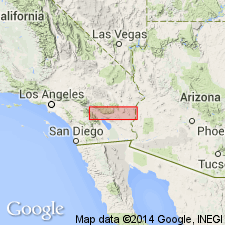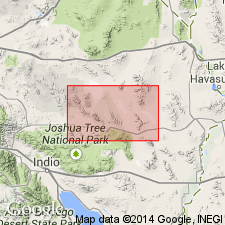
- Usage in publication:
-
- Coxcomb granodiorite
- Modifications:
-
- Named
- Dominant lithology:
-
- Granodiorite
- AAPG geologic province:
-
- Salton basin
Summary:
Unit is named the Coxcomb granodiorite for exposures in the middle part of Coxcomb Mountains, Riverside Co. CA. Consists of light gray granodiorite. Is uniform in texture, composition, and structure. Cuts steeply dipping beds of McCoy Mountains formation (new). Age is Late Jurassic(?) on map.
Source: GNU records (USGS DDS-6; Menlo GNULEX).

- Usage in publication:
-
- Coxcomb Intrusive Suite*
- Modifications:
-
- Adopted
- Dominant lithology:
-
- Granite
- Granodiorite
- Quartz monzodiorite
- AAPG geologic province:
-
- Mojave basin
Summary:
Coxcomb Granodiorite of Miller (1944) is adopted as the Coxcomb Intrusive Suite to clarify its areal distribution and to subdivide it into numerous mappable units of granite and granodiorite. Includes the Sheep Hole Mountains Granodiorite, Sheep Hole Pass Granite, Clarks Pass Granodiorite, and other unnamed units. Consists of light-colored granite, granodiorite, and minor quartz monzodiorite. Occupies much of the Coxcomb, Calumet, and southern Calumet Mountains and Kilbeck Hills, and major parts of the Sheep Hole and eastern Bullion Mountains. Comprises the largest part of the Cadiz Valley batholith. Age is Late Cretaceous (about 70 Ma) based on isotopic (U-Pb; zircon) from the Clarks Pass Granodiorite and from a granodiorite body south of the Sheep Hole Mountains 30' x 60' quad (Calzia and others, 1986; Wright and others, 1987).
Source: GNU records (USGS DDS-6; Menlo GNULEX).
For more information, please contact Nancy Stamm, Geologic Names Committee Secretary.
Asterisk (*) indicates published by U.S. Geological Survey authors.
"No current usage" (†) implies that a name has been abandoned or has fallen into disuse. Former usage and, if known, replacement name given in parentheses ( ).
Slash (/) indicates name conflicts with nomenclatural guidelines (CSN, 1933; ACSN, 1961, 1970; NACSN, 1983, 2005, 2021). May be explained within brackets ([ ]).

